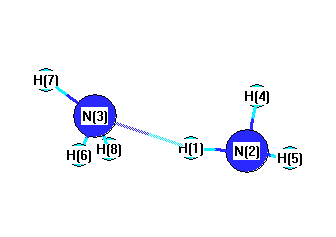Vibrational Frequencies calculated at CCSD(T)/cc-pVQZ
| Mode Number |
Symmetry |
Frequency
(cm-1) |
Scaled Frequency
(cm-1) |
IR Intensities
(km mol-1) |
Raman Act
(Å4/u) |
Dep P |
Dep U |
|---|
| 1 |
Ag |
3597 |
3488 |
|
|
|
|
| 2 |
Ag |
3471 |
3366 |
|
|
|
|
| 3 |
Ag |
1683 |
1632 |
|
|
|
|
| 4 |
Ag |
1109 |
1075 |
|
|
|
|
| 5 |
Ag |
412 |
400 |
|
|
|
|
| 6 |
Ag |
129 |
125 |
|
|
|
|
| 7 |
Au |
3608 |
3498 |
|
|
|
|
| 8 |
Au |
1694 |
1643 |
|
|
|
|
| 9 |
Au |
212 |
205 |
|
|
|
|
| 10 |
Au |
28 |
28 |
|
|
|
|
| 11 |
Bg |
3607 |
3498 |
|
|
|
|
| 12 |
Bg |
1685 |
1634 |
|
|
|
|
| 13 |
Bg |
81 |
78 |
|
|
|
|
| 14 |
Bu |
3597 |
3488 |
|
|
|
|
| 15 |
Bu |
3473 |
3368 |
|
|
|
|
| 16 |
Bu |
1665 |
1615 |
|
|
|
|
| 17 |
Bu |
1090 |
1057 |
|
|
|
|
| 18 |
Bu |
40i |
39i |
|
|
|
|
Unscaled Zero Point Vibrational Energy (zpe) 15549.7 cm
-1
Scaled (by 0.9697) Zero Point Vibrational Energy (zpe) 15078.5 cm
-1
See section
III.C.1 List or set vibrational scaling factors
to change the scale factors used here.
See section
III.C.2
Calculate a vibrational scaling factor for a given set of molecules
to determine the least squares best scaling factor.
